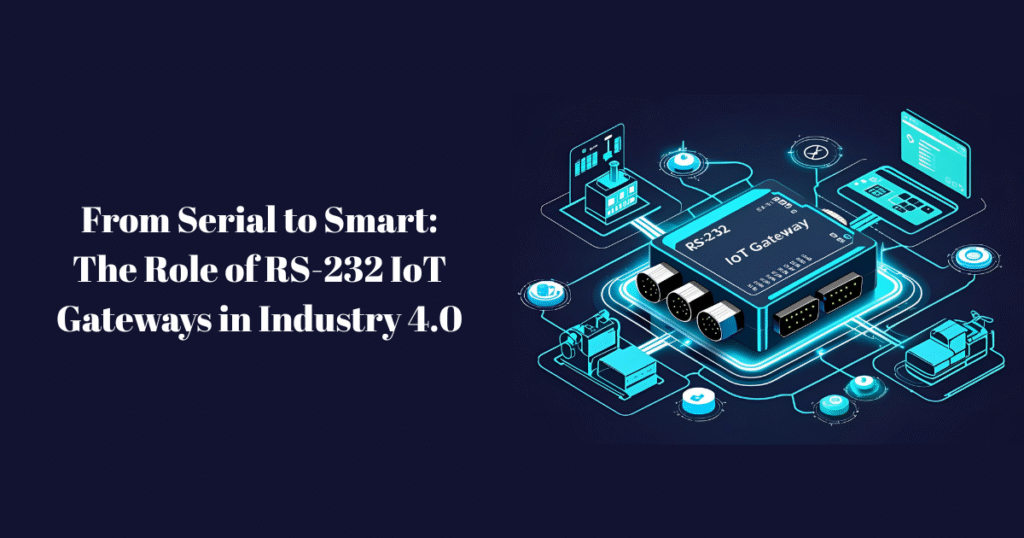
The fourth industrial revolution—Industry 4.0—has brought intelligent automation, real-time analytics, and cloud connectivity into the heart of industrial operations. However, a critical challenge persists: most factories, plants, and utility facilities are still heavily reliant on legacy equipment using outdated communication protocols like RS-232.
While these machines and instruments remain functional and vital to day-to-day operations, they were never designed to communicate over modern networks. The result? A technological divide between the old and the new. Fortunately, RS-232 IoT Gateways provide a solution.
By acting as a translator and bridge, an RS-232 IoT Gateway enables serial-based devices to become part of smart, connected, and data-driven ecosystems—crucial components of Industry 4.0.
What is RS-232 Communication?
RS-232, or Recommended Standard 232, is a long-standing electrical standard introduced in the 1960s. It defines how data is transmitted between devices using serial communication—typically one bit at a time—over a single channel.
RS-232 Key Characteristics:
- Point-to-Point Communication: Supports direct links between a Data Terminal Equipment (DTE) and a Data Communication Equipment (DCE).
- Voltage Levels: Uses ±12V for signaling, making it noise-immune in short-range industrial environments.
- Limited Distance: Typically supports communication up to 15 meters (50 feet).
- No Multipoint Support: Unlike RS-485, RS-232 doesn’t support multiple devices on a single bus.
Despite its limitations, RS-232 is still found in industrial environments, particularly in:
- PLCs
- Barcode Scanners
- CNC Machines
- Environmental Sensors
- Laboratory Equipment
These devices were built for reliability—not connectivity. That’s where the RS-232 IoT Gateway comes in.
Introduction to RS-232 IoT Gateway
An RS-232 IoT Gateway is a specialized device that enables legacy serial equipment to connect and communicate with modern IP-based networks. It acts as a protocol converter, translating serial data into formats compatible with IoT ecosystems, cloud platforms, and enterprise applications.
How It Works:
- Data Collection: The gateway reads raw serial data from RS-232-enabled devices.
- Protocol Translation: Converts the serial data into standard IoT protocols like MQTT, HTTP, CoAP, or Modbus TCP.
- Network Transmission: Sends the translated data over Ethernet, Wi-Fi, or 4G-LTE to the cloud or edge servers.
- Command Relay (Optional): Accepts commands from remote systems and sends them back to the serial device.
Supported Protocols:
- Modbus RTU ↔ Modbus TCP
- Serial ASCII ↔ MQTT
- Serial ↔ OPC UA
- Serial ↔ HTTP/HTTPS
Challenges with Legacy Equipment in Industrial Systems
Legacy systems pose serious limitations in the journey toward Industry 4.0 transformation:
Common Challenges:
- Isolation: RS-232 devices operate in silos, disconnected from broader enterprise systems.
- Manual Data Handling: Data often needs to be retrieved manually using USB sticks or local HMIs.
- Real-Time Blindness: No way to monitor or analyze equipment health in real time.
- Incompatibility: Can’t integrate with cloud-based dashboards, analytics platforms, or ERP systems.
Without a RS-232 IoT Gateway, these devices remain dumb endpoints—functioning but uninformed, unmonitored, and unoptimized.
How RS-232 IoT Gateways Enable Industry 4.0
Industry 4.0 depends on data visibility, connectivity, and interoperability. An RS-232 IoT Gateway transforms legacy serial systems into data-generating assets that integrate seamlessly with the modern industrial stack.
Key Industry 4.0 Enablers via RS-232 IoT Gateway:
| Capability | Enabled By |
| Remote Monitoring | Streams real-time data to central dashboards |
| Predictive Maintenance | Feeds sensor and machine data into analytics platforms |
| Data Logging | Stores and timestamps historical device output |
| Edge Intelligence | Local rule engines or scripts to analyze serial input |
| Cloud Connectivity | Integrates with AWS IoT, Azure IoT, or private cloud solutions |
With minimal disruption and cost, RS-232 IoT Gateways breathe new life into decades-old equipment, making them Industry 4.0-compatible.
Key Features of a Modern RS-232 IoT Gateway
When evaluating an RS-232 IoT Gateway for industrial applications, consider the following technical features:
Essential Features Checklist:
- Multi-Protocol Support: MQTT, HTTP/HTTPS, Modbus TCP, OPC UA, CoAP
- Serial Configuration: Baud rate, parity, stop bits, flow control settings
- Network Options: Ethernet, Wi-Fi, 4G/5G LTE
- Security: TLS/SSL encryption, VPN tunneling, user authentication
- Web UI & API: For configuration, diagnostics, and data access
- Cloud Integration: AWS, Azure, Google Cloud out-of-the-box
- Edge Scripting: Run Python or Lua scripts at the edge
- OTA Updates: Secure remote firmware updates
Example Vendors:
- Moxa
- Advantech
- Digi International
- Teltonika
- ICP DAS
Real-World Use Cases
Manufacturing Automation
- Problem: Old CNC machines generate useful performance data but are not network-connected.
- Solution: RS-232 IoT Gateway captures G-code execution stats and pushes them to a central MES or SCADA.
Water & Wastewater Utilities
- Problem: RS-232-enabled pH and flow sensors are disconnected from remote dashboards.
- Solution: Gateway bridges data to cloud-based monitoring applications for compliance and alerts.
Smart Agriculture
- Problem: Fertilizer injectors and irrigation timers with serial output need integration with weather data.
- Solution: Gateway syncs their output to a cloud platform that adjusts irrigation in real time.
Research Labs
- Problem: Serial lab instruments can’t interface with LIMS.
- Solution: Gateway converts RS-232 to HTTPS, sending test results directly to lab databases.
Security Considerations
Security is a top priority when bridging the physical and digital worlds. The RS-232 IoT Gateway should:
- Encrypt Data: Use TLS/SSL for MQTT and HTTPS
- Authenticate Devices: Use API tokens, username/passwords, and certificates
- Isolate Traffic: Use VLANs and firewalls to separate OT and IT networks
- Enable Logging: Track all communication and login events
- Prevent Downtime: Include fallback modes in case of network failure
Deployment Best Practices
To ensure a smooth and secure deployment of RS-232 IoT Gateways:
Best Practices:
- Label and document serial port settings before installation.
- Use shielded serial cables to minimize EMI in noisy environments.
- Map Modbus registers or command-response sequences accurately.
- Test in a lab environment before deploying to the field.
- Set up remote monitoring and alerts for gateway health.
- Back up configuration regularly to streamline replacement or updates.
Conclusion
As the industrial world embraces smart technologies, legacy systems must not be left behind. The RS-232 IoT Gateway is the essential enabler that empowers decades-old machines to contribute to modern digital workflows. It delivers secure, scalable, and cost-effective connectivity—turning serial devices into smart devices.
With the right gateway solution, businesses can transition from serial to smart, without the cost or risk of replacing their entire hardware ecosystem. It’s a smart step toward a fully integrated Industry 4.0 environment.
FAQs
1. What is an RS-232 IoT Gateway?
It’s a device that allows RS-232 serial equipment to communicate with IP networks, cloud platforms, or industrial IoT systems using modern protocols.
2. Can I integrate RS-232 devices into cloud platforms like AWS IoT?
Yes, most modern RS-232 IoT Gateways support MQTT and HTTPS, which are natively supported by cloud platforms.
3. Are RS-232 and RS-485 interchangeable?
No, they use different signaling and wiring. However, some gateways support both for flexibility.
4. How can I secure my RS-232 IoT Gateway?
Use encrypted communication (TLS), enable firewalls, set strong access credentials, and regularly update firmware.
5. Do RS-232 IoT Gateways require coding?
Not necessarily. Most gateways come with web-based interfaces for configuration. Advanced users can use APIs or edge scripting for custom logic.





